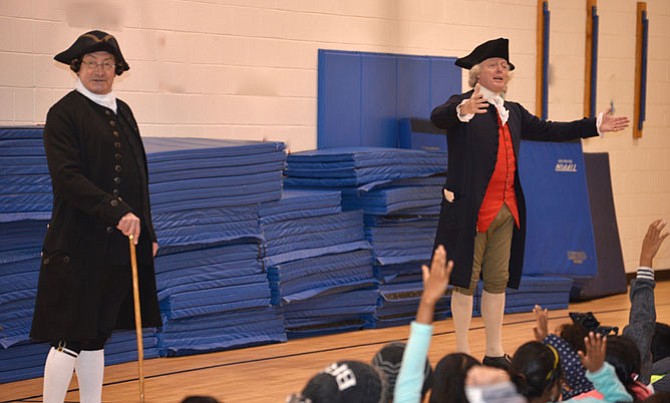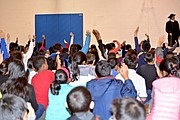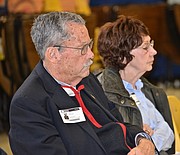Only minutes into the hour-long assembly at McNair Elementary School in Herndon, and “Patrick Henry” (brought to life by Richard Shumann) and “Thomas Jefferson” (realistically portrayed by Bill Barker) had all of the fourth and sixth graders seriously engaged. The pair of Colonial visitors have been re-enacting their characters for so many years, especially through the Colonial Williamsburg Foundation. Photo by Andrea Worker.
It’s a good thing that Thomas Jefferson and Patrick Henry were hardy souls, given the myriad of activities and actions and travelling and time that they both gave to the formation of “these new United States of America,” as our illustrious third President described the union the original thirteen colonies formed in 1776. It’s equally fortuitous that two of their modern day re-enactors seem to possess the same level of interest in that formation, even 241 years later, and a similar level of stamina – enough to have them bring their knowledge and enthusiasm to youngsters at eight different schools around the Fairfax County Public School (FCPS) system in just three days.
Richard Shumann (AKA Patrick Henry) and Bill Barker (otherwise known as Thomas Jefferson) brought their “always in persona” living history lesson to hour-long assemblies of elementary school students in Falls Church, McLean, Chantilly, Herndon and Reston, and if you had been fortunate enough to attend one of these events, you would have found their presentation and energy as fresh at the last assembly of the day as at the first, some six hours earlier. The two men interpret their character for the Colonial Williamsburg Foundation and have been doing so for years.
There was very little “oration,” as “Mr. Henry” described his introduction at each school. Instead, the program relied primarily on engaging the audience first with the visual of their costumed appearance, and then by simply letting them loose with whatever questions they had. Apparently a sound plan. The youngsters quickly caught on and got on board. There was never one of those awkward silences. You know. “Questions anyone? Anyone?” Hands were constantly being waved by students who wanted to know more about the men who influenced the founding of our country and the times they lived in. “I really enjoyed when they started to answer questions from us,” was Chinmay Bhandaru’s comment after the assembly at McNair Elementary in Herndon. “I loved that they really acted like Patrick Henry and Thomas Jefferson! They acted like friends, and would sometimes disagree on things,” said Chinmay’s schoolmate Deccan Maniam.
KUDOS, by the way, to the teachers and staff at McNair, the second stop on Wednesday’s whirlwind tour. The assembled students seemed to already have a firm grasp on the subjects of the day. One young lady stood up and asked “Mr. Henry” if he would mind repeating a bit of his most famous speech. “Mr. Jefferson” quipped that his “esteemed friend” would never mind being asked to “orate” and any time or place, and as “Mr. Henry” finished his words with a shouted-out “Give me Liberty or give me Death,” the assembly applauded vigorously.
The questions kept coming, but nothing seemed to stump the Colonial visitors who answered always in the language and context of their “times.” “It was amazing how they knew so much information,” marvelled Srihan Kotnana. Both “Mr. Jefferson” and “Mr. Henry” openly expressed their delight at their knowledge and the quality of the questions that the fourth and sixth graders asked.
“Well done, Sir! Excellent question,” praised “Mr. Henry,” when asked why he had opposed the passage of the United States Constitution. “I am a Virginian,” he replied, “and wish to remain so.” Despite Henry’s passionate belief in the need for the Colonies to free themselves from the “tyranny of that most unpleasant of men, King George III,” the real Patrick Henry did not believe that a united Federalist system was a good idea. Indeed, he predicted that to establish the government in that way would ultimately lead to a civil war.
Regardless of where the far-ranging conversation took them, “Henry” and “Jefferson” somehow always found a way to artfully weave in some of the central themes behind their program.
“Jefferson” often found ways to remind his audience about the need for education and how lucky they were to have it so readily accessible to them. With an anecdote about how his “Declaration of Independence” was often “tossed into the gutter when handed to the citizenry, “Jefferson” had the students looking aghast. “Why would they do that?” shouted out a few. “Why do you think?” he asked back. A small moment of silent contemplation, and one young lady tentatively responded, “Because they couldn’t read it?” Exactly so, young lady!” said “Mr. Jefferson.”
In the days of Henry and Jefferson, they were told, it was usually only white, rich males from landed families who had the education to read. “Don’t squander this amazing opportunity that you have,” was the advice given to the students.
The two men also spoke strongly about civic responsibility, telling their audience that the fate of the nation would pass into their hands. “History does, indeed, repeat itself,” warned “Henry.” He insisted that to deal wisely with the present and the future required understanding of the past. “If you know your History, you will be better prepared.”
THE OPPORTUNITY to see “History come to life,” as the program was described by McNair student Ayesha Kapoor, is made possible by the generous, personal funding of Jim and CarolAnn Babcock, both retired engineers who reside in Reston. The Babcocks have been partnering with The Colonial Williamsburg Foundation for about 8 years, each January bringing the informative and engaging program to schools in the Fairfax County system.
“We’ve always believed that understanding history in essential to understanding who we are as a country and a people,” said Mrs. Babcock. They also like that a key focus of the program is helping the students to learn to research and to seek the “primary sources,” rather than just accepting “circular reporting.” In a day and age when the phrase “fake news” is being heard so often, the Babcocks want to do whatever they can to promote education and fact-finding. Over the years, their “gift to the future” has expanded from five schools, to twenty-two. All of the schools on the 2017 tour were new recipients of the Babcock mission.
The Babcocks not only fund the program, but they personally attend the assemblies, as well. In addition, they also provide scholarships for teachers to attend a one-week educational course at Colonial Williamsburg. This summer, the Babcocks will be sending 17 teachers to the Teachers’ Institute. They are also helping to provide “Hands-on-History Kits” – one for each FCPS region - that contain items related to soldiers, slaves, and Native Americans of the Colonial times.
All of this seems like a lot of work, but CarolAnn insists that “It’s a project of love. It really keeps us going, and we are doing what’s important for the future of our country.”


